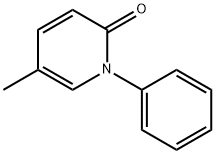Pirfenidone , ≥98%(GC) , 53179-13-8
Synonym(s):
5-Methyl-1-phenyl-2-(1H)-pyridone
CAS NO.:53179-13-8
Empirical Formula: C12H11NO
Molecular Weight: 185.22
MDL number: MFCD00866047
EINECS: 621-260-7
| Pack Size | Price | Stock | Quantity |
| 100MG | RMB27.20 | In Stock |
|
| 250MG | RMB35.20 | In Stock |
|
| 1G | RMB87.20 | In Stock |
|
| 5g | RMB274.40 | In Stock |
|
| 25g | RMB758.40 | In Stock |
|
| 100g | RMB2638.40 | In Stock |
|
| others | Enquire |
PRODUCT Properties
| Melting point: | 96-97°C |
| Boiling point: | 329.1±15.0 °C(Predicted) |
| Density | 1.137±0.06 g/cm3(Predicted) |
| storage temp. | Sealed in dry,Room Temperature |
| solubility | DMSO: ≥10 mg/mL, soluble |
| form | solid |
| pka | -0.16±0.63(Predicted) |
| color | Off-white |
| Water Solubility | Soluble to 20 mM in water |
| Stability: | Stable for 2 years from date of purchase as supplied. Solutions in DMSO may be stored at -20°C for up to 1 month. |
| InChI | InChI=1S/C12H11NO/c1-10-7-8-12(14)13(9-10)11-5-3-2-4-6-11/h2-9H,1H3 |
| InChIKey | ISWRGOKTTBVCFA-UHFFFAOYSA-N |
| SMILES | C1(=O)N(C2=CC=CC=C2)C=C(C)C=C1 |
| CAS DataBase Reference | 53179-13-8(CAS DataBase Reference) |
Description and Uses
Until recently, IPF therapy consisted of a combination of corticosteroids and immunosuppressive agents (azathioprine and cyclophosphamide) to target the inflammation that was believed to be the pathogenic stimulus.Since IPF is now considered to be predominantly a disorder of fibroproliferation, agents that intervene in fibrogenesis have moved to the forefront of treatment options. With demonstrated efficacy in a bleomycin-induced lung fibrosis animal model, pirfenidone has been developed and launched as an approved therapy for IPF. Its antifibrotic activity is derived from the inhibition of p38 MAP kinase that is upstream of transforming growth factor-β (TGF-β), a cytokine implicated in the stimulation of collagen synthesis and the inhibition of its degradation. Pirfenidone also inhibits the expression of TNF-α, IL-1, and ICAM-1, so it possesses the dual benefit of an anti-inflammatory and antifibrotic agent. This relatively simplistic drug is constructed by the copper-catalyzed reaction of 5-methyl-2(1H)-pyridinone with bromo- or chlorobenzene. .
Pirfenidone has been used:
- as a post-operative eye drop in rabbits to analyse its antifibrotic effect to improve glaucoma filtration surgery
- as an anti-scarring agent to examine whether it affects the foreign body reaction after glaucoma drainage device (GDD) implantation in a rabbit
- to test its antifibrotic potential in primary cultures of human orbital fibroblasts (hOFs)
- as tumor necrosis factor (TNFα) inhibitor to study its effect in hypoxia
Safety
| Symbol(GHS) |  GHS07 |
| Signal word | Warning |
| Hazard statements | H302 |
| Precautionary statements | P301+P312+P330 |
| Hazard Codes | Xn |
| Risk Statements | 22 |
| Safety Statements | 36-24/25 |
| WGK Germany | 3 |
| RTECS | UV1148200 |
| HS Code | 29337900 |
| Hazardous Substances Data | 53179-13-8(Hazardous Substances Data) |



